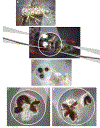Determining the Insemination Status of Aedes Mosquitoes
- PMID: 35902241
- PMCID: PMC9883591
- DOI: 10.1101/pdb.prot107954
Determining the Insemination Status of Aedes Mosquitoes
Abstract
Within the genus Aedes, the reproductive biology of two species has been most thoroughly studied: Aedes aegypti and Aedes albopictus In these species, females tend to copulate with one or more males once sexually mature. Within a few hours after an initial insemination, most females become refractory to insemination for the rest of their lives. Aedes females store sperm in three sclerotized spherical structures called spermathecae, where they can remain viable for >3 mo after copulation. This protocol outlines a quick (∼3-5 min per female once you are practiced in dissection) and effective method for dissecting the female spermathecae from Ae. aegypti and Ae. albopictus mosquitoes and scoring them for the presence or absence of sperm in cases in which the researcher does not need the female for further studies.
© 2022 Cold Spring Harbor Laboratory Press.
Figures

Similar articles
-
Insemination in Aedes aegypti and Aedes albopictus.Cold Spring Harb Protoc. 2022 Jul 28:10.1101/pdb.top107668. doi: 10.1101/pdb.top107668. Online ahead of print. Cold Spring Harb Protoc. 2022. PMID: 35902240 Free PMC article.
-
A Peptide Signaling System that Rapidly Enforces Paternity in the Aedes aegypti Mosquito.Curr Biol. 2017 Dec 4;27(23):3734-3742.e5. doi: 10.1016/j.cub.2017.10.074. Epub 2017 Nov 22. Curr Biol. 2017. PMID: 29174895 Free PMC article.
-
Satyrization without evidence of successful insemination from interspecific mating between invasive mosquitoes.Biol Lett. 2015 Sep;11(9):20150527. doi: 10.1098/rsbl.2015.0527. Biol Lett. 2015. PMID: 26382076 Free PMC article.
-
Cross-mating between Malaysian strains of Aedes aegypti and Aedes albopictus in the laboratory.Southeast Asian J Trop Med Public Health. 2009 Jan;40(1):40-6. Southeast Asian J Trop Med Public Health. 2009. PMID: 19323032
-
Satyrization and satyrization-resistance in competitive displacements of invasive mosquito species.Insect Sci. 2016 Apr;23(2):162-74. doi: 10.1111/1744-7917.12291. Epub 2016 Jan 18. Insect Sci. 2016. PMID: 26542083 Review.
Cited by
-
Aedes aegypti reproductive aspects: constant light significantly affects the embryonic development.Mem Inst Oswaldo Cruz. 2025 Mar 31;120:e240233. doi: 10.1590/0074-02760240233. eCollection 2025. Mem Inst Oswaldo Cruz. 2025. PMID: 40172429 Free PMC article.
-
Insemination in Aedes aegypti and Aedes albopictus.Cold Spring Harb Protoc. 2022 Jul 28:10.1101/pdb.top107668. doi: 10.1101/pdb.top107668. Online ahead of print. Cold Spring Harb Protoc. 2022. PMID: 35902240 Free PMC article.
References
-
- Aldersley A, Pongsiri A, Bunmee K, Kijchalao U, Chittham W, Fansiri T, Pathawong N, Qureshi A, Harrington L, Ponlawat A, et al. 2019. Too “sexy” for the field? Paired measures of laboratory and semi-field performance highlight variability in the apparent mating fitness of Aedes aegypti transgenic strains. Parasit Vectors 12: 357. doi:10.1186/s13071-019-3617-2 - DOI - PMC - PubMed
Grants and funding
LinkOut - more resources
Full Text Sources
